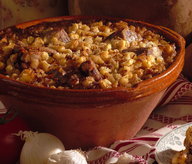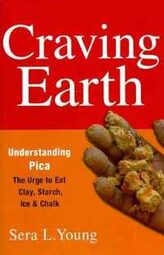Food Books
Food, Culture, Memory
"Feeding people was an act of love." A woman living in a big city recalls her mother's generous labor feeding farm crews during harvest time in Iowa. She begins to reach out to her own community of laborers--people doing renovations--with her own, smaller, version of urban generosity. It works, sort of.
Another woman moves from a vibrant foodie hub to Tallahassee, Florida, and begins to learn how and where to find what's fresh, what's the best. Cassoulet photo via Le Blog
Cassoulet photo via Le Blog
Tales from all sorts of people, 29 original essays on what they eat, what it meant/means, how food figures in their lives well beyond the table, plus, recipes, comprise The Cassoulet Saved Our Marriage: True Tales of Food, Family, and How We Learn to Eat edited by Caroline Grant and Lisa Catherine Harper. It's a feast.
We won't divulge the cassoulet tale here....Published by Shambhala.
Food & Faith in Christian Culture
 We celebrate with food, and Lord knows, religious traditions involve celebration, and its less voluptuous opposite, fasting. Aside from that, many religious institutions have issues with certain foods---pig-related vittels come to mind right off. Coffee and wine, meat on Friday, are no-no's for others. But bread, of course, is deeply entrenched in both Christian and Jewish traditions, leavened and unleavened, and seemingly is so inherent a part of the world's intake as to escape censure. ( Did the writers of the Bible even know of rice, the food staple of half the planet these days? Doubtless not, ancient though it is.)
We celebrate with food, and Lord knows, religious traditions involve celebration, and its less voluptuous opposite, fasting. Aside from that, many religious institutions have issues with certain foods---pig-related vittels come to mind right off. Coffee and wine, meat on Friday, are no-no's for others. But bread, of course, is deeply entrenched in both Christian and Jewish traditions, leavened and unleavened, and seemingly is so inherent a part of the world's intake as to escape censure. ( Did the writers of the Bible even know of rice, the food staple of half the planet these days? Doubtless not, ancient though it is.)
Columbia University Press' book features The Supper at Emmaus, by Caravaggio, on its cover, showing bread, wine jugs, a dead fowl, and a bowl of fruit, the latter clinging to the edge of the table. Now let's face it, presumably Jesus Christ at this point was not into eating, having just risen from the dead, and his two loyal disciples appear too blown away by the astonishing return of their leader to have much appetite either.
Yet, there it is. A meal. Cooked, baked, served up, on a clean tablecloth. Nice. Perhaps the help ate this meal, a bit later, after the hubbub had died down, ate it in appreciative silence, another religious food custom one often longs for these days.
Food & Faith, edited by Ken Albala and Trudy Eden, is rich in history, detail, and thoughtful musings. Dive in.
Cheese and Culture
While the egg may have come before the chicken, or not....., decidedly cheese came before milk, at least in the sense that it's apparent that adults made and ate cheese long before they drank the main ingredient.( Children up to a certain age were lactose tolerant, but their parents likely were not.)
By 7000 BC animal domestication in southwest Asia was well in hand, but animals such as goats and cattle were slaughtered for meat, not raised to produce milk. Somehow--people who were "good" with animals persuaded these critters to allow themselves to be milked, and soon an abundance of milk became an issue. (About 6500 BC. for the first time pottery shards began to show traces of dairy.) Abundance requires some kind of processing and storage. Cheese was the solution, and the development of reliable pottery, as well as basketry, was in aid of this, too.

Roman cheese press from The British Museum
For cheese and history lovers, all this is just the beginning, in Vermonter Paul Kindstedt's dense book that covers the role of cheese in Western civilization. Not surprisingly, Greece, where feta cheese dates back to 4000 BC, had a cheese God, Aristaios, whose brother, Asklepios, became the medical/healing god, and in whose "hospital," cheese likely was a medicament. Kindstedt reminds us that the author of the beleaguered Job story---he who used a rennet coagulation metaphor when asking --"Do you not pour me out like milk and curdle me like cheese?" was anticipating the much later observations of the mighty Greek philosopher, Aristotle, who was said to have had a hand in cheese-making himself.
Leaping ahead, we Americans can thank the Puritans for infusing their new homeland with a range of those spectacular hard-cheeses known as cheddars that persists to this day. And kudos to the author for also pointing out the uncomfortable truth that the self-satisfied Puritans "became entangled... in human trafficking," were reprehensible towards native Americans, and insured that their descendants benefited financially for generations from slave labor, trade, and all that.
"Cheese and Culture, A History of Cheese and Its Place in Western Civilization," by Paul S. Kindstedt, Chelsea Green Publishing, Vermont.
Peanut Butter!

Just chatting with Jon Krampner on the phone is a hoot---he's a mellow kind of fellow with a wicked sense of humor, and his book on the all-American food sounds exactly like him, albeit packed with info, leguminous lore, and more.
He's done his historical research well, his interviews with p. nutters sparkle, and his exploration of the industry is altogether too enlightening. Slavery to salmonella, it's all here. Stick with organic/no sugar added/peanut butter, please, and if you want to drink your favorite spread, try the book's recipe for Frozen Peanut Butter Brandy Alexander. ( There are other recipes, too.)
Thanks to Columbia University Press for making possible yet another fine food book.
Florida Food, Now on the Map
 Here's a leisurely, rich stroll through the foods, farms, and restaurants of Florida, from lychees to limes, with Pam Brandon, Katie Farmand and Heather McPherson. "Field to Feast," published by University Press of Florida, unveils history, shares recipes, and chronicles where to find what where in the Sunshine State, including a place near Miami that specializes in bananas, 90 varieties of them. Potato growers of early varieties in Hastings offer up a recipe for Potato and Tatsoi Pizza, a Pensacoloa chef reveals his secret ways with triggerfish.
Here's a leisurely, rich stroll through the foods, farms, and restaurants of Florida, from lychees to limes, with Pam Brandon, Katie Farmand and Heather McPherson. "Field to Feast," published by University Press of Florida, unveils history, shares recipes, and chronicles where to find what where in the Sunshine State, including a place near Miami that specializes in bananas, 90 varieties of them. Potato growers of early varieties in Hastings offer up a recipe for Potato and Tatsoi Pizza, a Pensacoloa chef reveals his secret ways with triggerfish.
Taste, Memory: Forgotten Foods, Lost Flavors, and Why They Matter

David Buchanan's book describes food's "sense of place," a concept not at all unknown to, say, the French. In France "terroir" matters---where one grows what. Tradition matters. Continuity matters, and in France losing foods is less of an issue than in these United States. ( A little less.) Buchanan's book cover features an heirloom apple, for me, a key connection to my own childhood food memories, growing up in New York State. Crisp unsweet, yet sweet enough apples! Now that I am neither a kid, nor living in upstate New York, my effort to find unsweet apples continues. A grower in New Mexico once had some small no-name apples she was was tossing in a bag for $1. Total.
When I brought them home, and bit into one, then two, then three, I realized I had bagged a treasure from the past. Apples needed right now in the present.
Now Buchanan gets all this. In fact, he lives it, more than ever, on a farm in Pownal, Maine, not far from Portland. His book nominally is about bio-diversity, eating local, and all that. But his particular quietly lyrical spin on the topic, his personal explorations of heritage and history, family, seeds, and geography, keep the reader turning pages, or clicking doohickeys, to learn more. A beauty of a book, from Chelsea Green in Vermont.
Visual Food Histories: UK Chocs, and Sweets

Two visually arresting books--rather like Tumblrs in book form--explore the histories of pioneering British chocolate companies, and the story of sweets in the UK, with particular emphasis on Yorkshire, home to more Brit confectioners than any other locale.
Both by historian Paul Chrystal, and both published by Amberly Books, each book's history keys off vintage photos, advertising materials, tins, packaging and other illustrative materials.
From The FOOD Museum's Tom and Meredith Hughes, our book on France's food historic culture, from Bunker Hill Publishing.
Pica for Lunch? "Craving Earth"
 "Human beings have eaten earth, on purpose, for more than 2300 years." So states the copy on the dust jacket of this completely original, well-written, wide-net book about the craving for and ingesting of non foods, known as pica. People around the world eat clayaish earth, starch, ice, even chalk. The majority of these are pregnant women, or kids.
"Human beings have eaten earth, on purpose, for more than 2300 years." So states the copy on the dust jacket of this completely original, well-written, wide-net book about the craving for and ingesting of non foods, known as pica. People around the world eat clayaish earth, starch, ice, even chalk. The majority of these are pregnant women, or kids.
The author, Sera Young, on the faculty at Cornell in Nutritional Sciences, began noting this pica thing during research travels, and when she asked women on a Zanzibar island she was interacting with why they were eating chunks of earth from their homes, they had no answer. One of them suggested Ms Young do the research and find out for herself.
Eating dirt is no happy slappy out in the open indulgence--it is considered odd, unhealthy, or worse, and generally those who eat what the rest of us decline are condemned for it. Young even finds evidence that slaves who had a fondness for dirt were muzzled by metal masks, at least in one instance in Brazil.
Another winner from Columbia University Press.





